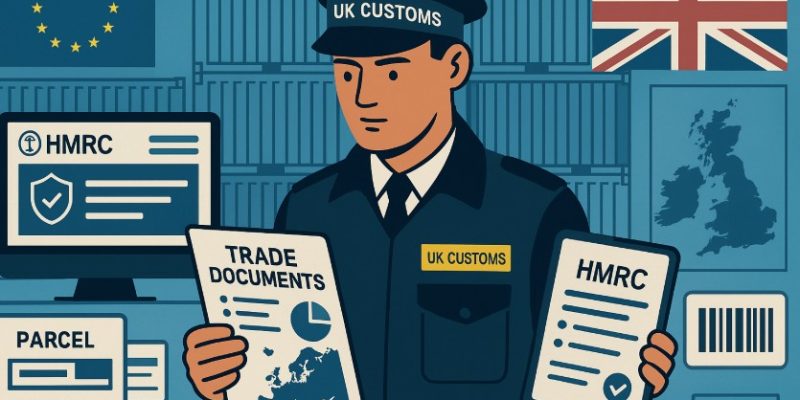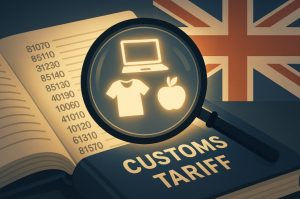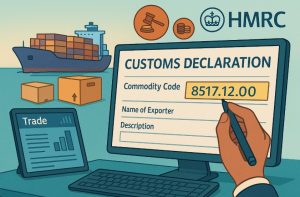
HMRC Commodity Codes and Customs Declarations: What You Need to Know
In the intricate world of international trade, correctly identifying and classifying goods is not just best practice it’s a legal requirement.
HMRC commodity codes are a crucial component in this process, and using the wrong one could lead to unexpected delays, incorrect tax charges, or even fines.
This guide provides essential information for businesses in the UK navigating the complexities of HMRC commodity codes and customs declarations.
What Are HMRC Commodity Codes and Why Are They Important?

HMRC commodity codes are numerical identifiers used to describe products in international trade.
They are based on the Harmonised System (HS), a global product classification structure used by most countries.
These codes play a central role in customs procedures, as they determine how goods are treated at the UK border.
From calculating customs duty and VAT to determining import/export restrictions, these codes influence many aspects of international transactions.
Each commodity code relates to a specific type of good and is used when completing import and export declarations.
For example, if a business imports electronic devices from outside the UK, they must classify the product correctly using the applicable code in their customs documentation.
If the code is incorrect, the business could be subject to additional checks, incorrect duties, or even penalties.
The importance of accurate classification is magnified by the UK’s departure from the EU, which has led to changes in tariffs and preferential treatment under various trade agreements.
Commodity codes ensure that goods are treated correctly according to UK customs regulations, particularly in cases where products are subject to additional measures such as quotas or anti-dumping duties.
How Does the UK Trade Tariff Work with HMRC Commodity Codes?
The UK Trade Tariff is a government resource that provides the full set of commodity codes alongside information about import duties, VAT, trade restrictions, and licensing requirements.
Businesses can use the online Tariff Lookup Tool to search for their product and find the associated 10-digit commodity code.
The structure of a typical commodity code is as follows:
| Section | Digits | Description |
| Harmonised System (HS) Code | First 6 digits | International standard for classification |
| Combined Nomenclature (CN) | 7th and 8th | EU-derived classification for more detail |
| UK-specific Tariff Code | 9th and 10th | Domestic additions to identify duties |
For example, a product classified under code 8517120000 could be a mobile phone.
The first 6 digits 851712 represent the general category globally, while the last 4 digits provide EU and UK-specific classification detail.
This helps HMRC apply the correct duty rates, restrictions, or exemptions when the item is declared at customs.
The tariff tool also identifies whether licences are required to move goods or whether the product benefits from reduced duty under existing trade agreements.
It ensures transparency in customs processes and enables importers and exporters to prepare declarations accurately and in compliance with UK law.
How Can You Classify Goods Correctly for Import and Export?

Classifying goods correctly is a legal obligation for all UK importers and exporters.
Every product that crosses a border must be declared using a precise commodity code.
This classification determines how goods are treated under customs regulations, including the amount of duty payable, the applicable VAT rate, and whether import or export restrictions apply.
Why Proper Classification Matters?
Incorrect classification can lead to:
- Overpayment or underpayment of customs duties and VAT
- Delays at ports and border control
- Non-compliance penalties or retrospective tax claims
- Difficulty accessing preferential trade agreements
For businesses engaged in regular trade, consistently accurate classification is essential not only for compliance but also for maintaining supply chain efficiency and controlling operational costs.
Steps to Classify Goods Accurately
1. Understand the Product in Detail: The classification process starts with a comprehensive understanding of the item. Factors to consider include:
- Material composition
- Function or intended use
- Manufacturing method
- Product form and packaging
- Any included accessories or bundled items
For example, a toy drone may appear straightforward but may fall under different headings depending on whether it includes a camera, GPS, or software for flight control.
2. Use the UK Trade Tariff Tool: The GOV.UK Trade Tariff tool is the most authoritative resource for finding the correct commodity code. It allows users to:
- Browse by category or keyword
- Compare product descriptions
- Review duty and VAT rates
- Identify licensing or certification requirements
By comparing product characteristics with code descriptions, traders can make an informed decision.
3. Consult Explanatory Notes and Classification Guidance: For certain product types, HMRC and international bodies like the World Customs Organization provide explanatory notes. These documents offer:
- Definitions of technical terms
- Examples of inclusions and exclusions for each code
- Rulings on specific classification disputes
This additional material can be critical when classifying goods that don’t clearly fall into a single category.
4. Refer to Industry-Specific Guidelines: HMRC provides classification guidance for industries where products are complex or often misclassified. These include:
- Electronics: Includes phones, tablets, and chargers
- Pharmaceuticals and supplements: Differentiating between food, medicine, and herbal products
- Textiles and apparel: Based on fabric type, gender, and garment type
- Vehicles and parts: With multiple classifications based on engine type, weight, and configuration
- Toys and educational products: Where distinction depends on whether a product is considered educational or recreational
5. Request Binding Tariff Information (BTI): If uncertainty remains, businesses can apply for Binding Tariff Information (BTI) from HMRC. A BTI ruling is:
- Legally binding across all EU and UK customs authorities
- Valid for 3 years
- Specific to the product and business requesting it
It provides legal certainty for classification and can help businesses avoid future disputes or penalties.
Common Classification Challenges
| Product Type | Classification Difficulty | Notes |
| Health supplements | High | Depends on whether it’s food, medicine, or herbal |
| Tech accessories | Medium | Varies by intended use (e.g., power bank vs. charger) |
| Mixed-material products | High | Dominant material and use determine classification |
| Clothing sets or gift boxes | High | Must classify by primary function or value |
| Smart devices (IoT) | Medium to High | Can fall under computers, telecom, or household electronics |
It’s essential to analyse each product on a case-by-case basis rather than assume that similar items always share the same code. Even small differences in material or function can place an item under a completely different tariff heading.
Using Supplier Codes Cautiously
A common mistake made by UK businesses is relying on the commodity codes provided by overseas suppliers.
While many countries use the same first six digits of the Harmonised System (HS), the remaining digits can vary from country to country.
For instance:
- A code provided by a Chinese manufacturer may be valid in China but incomplete or invalid under UK tariffs
- An EU code might include details that the UK has now updated post-Brexit
Always cross-check foreign codes with the UK Trade Tariff to ensure alignment with UK customs regulations. If in doubt, consult a customs broker or apply for BTI to avoid errors.
Classification in Post-Brexit Trade
Since the UK left the EU, its tariff regime has diverged in certain areas. Businesses must now:
- Use the UK Global Tariff (UKGT) for imports
- Ensure compliance with UK-specific trade agreements, which may affect duty rates
- Understand rules of origin when claiming preferential rates
Misclassification may result in the denial of preference, requiring full tariffs to be paid even if a trade agreement exists. This further highlights the need for precision in classification.
What Role Do Commodity Codes Play in Customs Declarations?

In customs declarations, the commodity code is one of the most critical fields. It directly influences the following aspects:
- The amount of customs duty payable
- The applicable VAT rate
- Whether import or export licences are required
- Whether the product qualifies for preferential duty rates under trade agreements
- Whether specific regulatory controls or safety checks apply
The Customs Declaration Service (CDS), which is gradually replacing the older CHIEF system, uses the commodity code to cross-check data and ensure that correct duties and conditions are applied to the consignment.
Incorrect codes can trigger system warnings, leading to delays, manual reviews, and potentially seizure of goods at the border.
If goods are misclassified, it can result in either overpayment or underpayment of duties.
Both outcomes are undesirable. Overpayment affects the profitability of the transaction, while underpayment may be discovered during HMRC audits, leading to backdated payments and possible fines.
How Do You Use the GOV.UK Tariff Lookup Tool?
The Trade Tariff tool, available on GOV.UK, is the official resource for identifying and understanding HMRC commodity codes.
It includes a search function, keyword filters, duty rates, licensing requirements, and additional notes for each code.
Steps to Use the Tool
- Visit the GOV.UK Trade Tariff tool
- Enter a keyword or browse the sections based on product category
- Review all suggested codes and choose the one that best describes your product
- Check the details, including:
- Duty rates for different countries
- VAT application
- Measures like quotas or licensing
- Notes on usage and classification rules
Example Table:
| Product | Commodity Code | Import Duty | VAT Rate |
| Leather shoes | 6403511100 | 8.0% | 20% |
| Mobile phones | 8517120000 | 0% | 20% |
| Chocolate (with milk) | 1806201500 | 8.0% | 20% |
| Organic herbal tea | 2101202000 | 3.2% | 20% |
This tool ensures that businesses have full visibility into what importing or exporting a specific item will cost and what paperwork is required.
Using it properly can prevent costly mistakes and ensure declarations are accurate the first time.
What Are the Consequences of Using the Wrong Commodity Code?
Using an incorrect commodity code may seem like a small administrative error, but it can lead to serious financial and operational consequences. These include:
- Customs delays due to misidentified products
- Incorrect calculation of customs duty or VAT
- Increased scrutiny during audits
- Potential fines or penalties for non-compliance
- Reputational damage with clients or customs authorities
If the commodity code used in the declaration results in an underpayment of duty, HMRC can demand backdated payment for the difference, along with interest or additional penalties.
If the error is considered deliberate or negligent, this could escalate into a formal compliance issue.
In some cases, customs authorities may reject an import declaration entirely, leading to the consignment being held at port or returned to the sender. This can significantly increase costs and damage commercial relationships.
When Should You Contact HMRC for Help with Commodity Codes?

There are situations where self-classification becomes difficult or risky. For example, when:
- The product is a new innovation with no clear existing classification
- The product has dual-use applications
- The composition of the product is complex or mixed
- Previous declarations have been challenged
In such cases, businesses can use HMRC’s Tariff Classification Service or apply for Binding Tariff Information (BTI).
A BTI ruling provides a definitive, HMRC-approved commodity code for a specific product and is valid for three years. It can be used in all customs declarations for that product, reducing risk and ensuring consistency.
To request BTI, businesses need to provide detailed product information, including:
- Photographs or technical specifications
- Materials used
- Intended use
- Any relevant marketing descriptions
It is also advisable to seek help from a customs broker or freight forwarder experienced in UK classification standards, especially for high-volume imports or regulated products.
How Do Customs Systems Like CDS and CHIEF Handle Commodity Codes?
The Customs Declaration Service (CDS) is the UK’s primary system for managing import and export declarations.
It has replaced the CHIEF (Customs Handling of Import and Export Freight) system for most businesses and offers a more digital and integrated process.
Both systems rely on accurate commodity codes to:
- Validate declarations
- Apply duty and VAT calculations
- Trigger any associated checks, such as health and safety requirements
- Confirm if any special procedures or suspensions apply
CDS introduces additional validation layers. If the commodity code used does not align with expected data (such as country of origin or product description), the system may reject the declaration.
For traders who have transitioned to CDS, it is essential to ensure that product databases and declaration templates are updated to reflect the correct codes.
While CHIEF is still available for certain use cases, businesses are encouraged to make the switch to CDS to align with HMRC’s long-term customs digitisation strategy.
What Are the Best Practices for Ensuring Compliance?

To reduce risk and improve efficiency in managing commodity codes, businesses should adopt a structured compliance approach:
- Maintain a centralised product database with accurate commodity codes
- Schedule regular reviews of classifications to reflect any changes
- Monitor updates to the UK Global Tariff and related trade agreements
- Train staff responsible for customs documentation
- Use software tools that validate and store classification data
- Document the rationale for each classification decision
Where possible, businesses should also consider applying for BTI for high-value or complex goods. This creates a paper trail and protects the company in case of future audits.
Conclusion
Accurate use of HMRC commodity codes is a fundamental aspect of importing and exporting in the UK.
It ensures correct duty and VAT payments, prevents customs delays, and keeps your business on the right side of the law.
Whether you’re a small startup or a seasoned exporter, mastering commodity codes is a non-negotiable part of trade success.
For official guidance, tools, and support, visit the UK Trade Tariff tool and consider seeking professional advice for complex goods.
FAQs About HMRC Commodity Codes
What is the structure of a commodity code?
A commodity code typically consists of 10 digits: the first 6 are harmonised globally, the next 2 follow EU classification, and the final 2 are UK-specific.
Are commodity codes the same across all countries?
No, only the first 6 digits are harmonised globally. The remaining digits differ between countries, which is why relying solely on a supplier’s code may be inaccurate for UK customs.
How often are HMRC commodity codes updated?
Commodity codes may be updated annually to reflect changes in trade agreements, tariffs, and product classifications. Traders should check codes regularly.
Can I change a commodity code after submitting a declaration?
Changes can be requested through HMRC post-clearance amendment procedures, but approval depends on specific conditions and evidence provided.
Do I need an EORI number to use commodity codes?
Yes, an EORI number is required for most customs declarations, and it links your business to your import/export activity.
Are there tools to automate commodity code selection?
Some trade platforms and customs software solutions offer AI-based classification tools, but final responsibility always lies with the business or declarant.
What if my product fits more than one commodity code?
In such cases, HMRC recommends seeking BTI or contacting the Tariff Classification Service for clarification.




